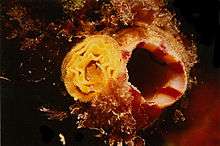Microcosmus sabatieri
| Microcosmus sabatieri | |
|---|---|
| Scientific classification | |
| Kingdom: | Animalia |
| Phylum: | Chordata |
| Subphylum: | Tunicata |
| Class: | Ascidiacea |
| Family: | Pyuridae |
| Genus: | Microcosmus |
| Species: | Microcosmus sabatieri |
| Binomial name | |
| Microcosmus sabatieri (Roule, 1885) | |
Microcosmus sabatieri is a species of tunicates (sea squirts). The species has a rocky-shape appearance. It is mainly found in the Mediterranean Sea.
It is used as food in parts of Europe, such as France and Italy, where it is known as a sea violet or sea fig.

Inhalant siphon of Microcosmos sabatieri. The yellow feature at the left is a clutch of mollusk eggs.
Use
Main article: Sea squirts as food
All species of Microcosmus are edible, but it is mainly M. sabatieri which is marketed.[1] In the Mediterranean, it is eaten raw, often with an acidic condiment such as lemon juice or vinegar with shallots. It has a strong iodine taste which not all appreciate.
Other names
Synonyms
Plants of the family Aizoaceae, the genus Carpobrotus, are also known as 'sea fig' in the Mediterranean.
Europe
Fishmongers in the Mediterranean also use the following names:
- Violet or Viourlet
- Biju ou Bijut ou Bichu
- Patate de mer
- Stronzi di mare. Referring to Sea cucumbers, echinoderms from the class Holothuroidea (Liguria)
- Limone di mare (Italy)
- Carnummole (Campania)
- Fouska (Greece)
- Morsko jaje (litt. "sea egg" (Croatia)
References
- ↑ cf. Ascidiacea#Culinary
External links
This article is issued from Wikipedia - version of the 10/10/2016. The text is available under the Creative Commons Attribution/Share Alike but additional terms may apply for the media files.